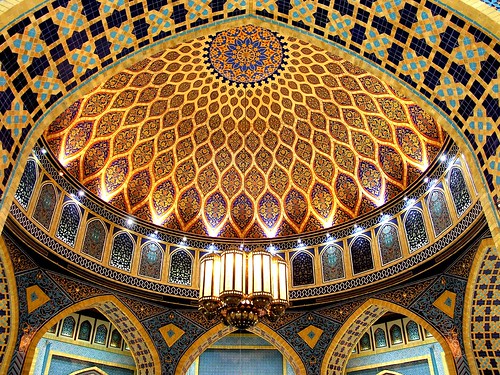Islamic Art

Introduction
Islamic art is a term that can be understood in several ways. Some definitions concentrate on the religious aspects of this art, giving pride of place to mosques architecture and calligraphy or treating Islamic art as the product of a culture in which not everyone was Muslim but in which Islam played a dominant role.
Islamic art is not an art pertaining to religion only. The term "Islamic" refers not only to the religion, but to the rich and varied Islamic culture as well. Over the course of a long Islamic period, the ruling elite of Caliphs, Emirs(princes), Shahs (Emperors of Iran), Sultans(Monarchs) and Viziers (Ministers or advisors), set the style in every aspect of civilized life, including artistic production.
There are repeating elements in Islamic art, such as the use of geometrical floral or vegetal designs in a repetition which known as "Arabesque". The arabesque in Islamic art is often used to symbolize the transcendent, indivisible and infinite nature of Allah.
Most Muslims believe that visual depictions of any living beings generally should be prohibited. Nonetheless, human portrayals can be found in all eras of Islamic art. But the human representation for the purpose of worship is considered idolatry and that is duly forbidden in Islamic law.
Art In Qur’an and Sunnah
Islam tends to moderation in all things, leads the natural talents in the right direction, and tries to develop in man a harmonious whole. In the Sahih of Muslim and the Musnad of Ibn Hanbal (Famous Islamic references), an interesting saying of Prophet Muhammed (Hadith): "God is beautiful and likes beauty." The taste for fine art is innate in man. As in the case of all other natural gifts, Islam seeks to develop the artistic talents with the spirit of moderation.
Allah has spoken in the Qur'an: "We have beautified the lower sky with lamps" (67:5)
"Lo! We have placed all that is on the earth as an ornamental thing that We may try men: which of them is best in conduct." (18:7),and It goes so far as to ordain: "Put on your dress of adornment on every occasion of prostration (service of prayer)." (7:31)
In the life of the Prophet, we come across the following instructive incident: One day he saw the interior of a grave which was not fully leveled. He ordered the defect to be mended, adding that it would do neither good nor harm to the dead, but it was more pleasant to the eye of the living, and whenever one does something, God likes that one does it in a perfect manner.
History has shown that this check on "figurative" art among Muslims has never curbed art in general; on the contrary an astonishing development was achieved in the non-figurative spheres. The Qur'an itself (24:36) recommended grandeur in the construction of mosques. The Prophet's Mosque at Madinah in Saudi Arabia, the Dome of the Rock at Jerusalem, the Sulaimaniyeh Mosque in Istanbul, , and others are in no way inferior to the masterpieces of other civilizations, either in architecture or in artistic decoration.
Islamic Art in the World
Great collections of Western art, such as the National Gallery in London, reflect centuries of contact with the Muslim world and admiration for Islamic art. While the European objects in the Gallery's permanent collection were chosen for their own aesthetic qualities and as exemplars of European culture, many reveal the broader international context of their time.
The Gallery's Late-Medieval and Renaissance-period collections reveal this European fascination with Islamic art--in depictions of the objects themselves and in the appropriation of Islamic designs. The portrait of an Italian cardinal making an ostentatious display of his fine Turkish carpet. The golden halo of a Florentine Madonna is patterned after a brass tray with an Arabic inscription from Syria or Egypt. Ceramics and metalwork made in Italy, France, and Germany were inspired not only by Islamic artistic forms and techniques but by Muslim customs as well.
Nineteenth-century French paintings such as Renoir's Odalisque show new interest in the scenery, people, and culture of Egypt and of French-occupied North Africa, which were often highly romanticized. Increasing foreign travel in the nineteenth century encouraged the collection of old Islamic objects. One of the Gallery's founding donors, for example, shared the growing esteem for early oriental carpets and presented several fine ones to the Gallery. These are the only Islamic objects in the collection but hardly the only appearance of Islamic art.

Architecture